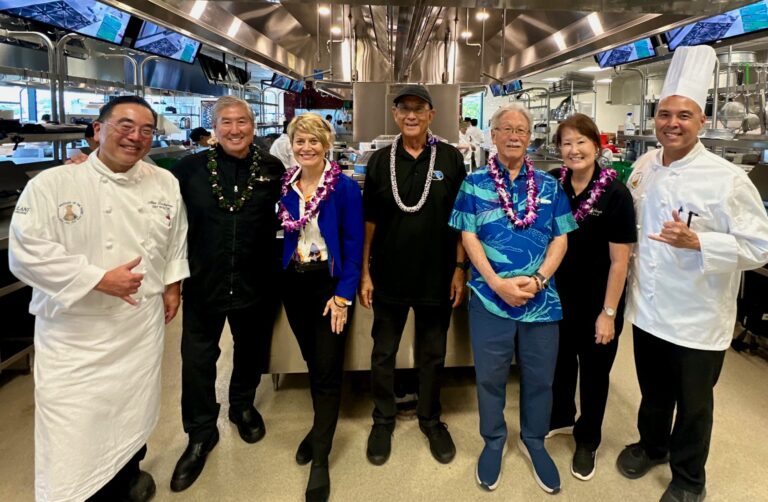
One day I asked a Kapiolani Community College student if she could cut ahi sashimi. I also told her she would have to take a quarter of a whole ahi — yellowfin tuna — and fabricate it into blocks before cutting it into sashimi.
She replied that she saw it being done in class and that students got a piece of the ahi but she never got the chance to do everything. The budget didn’t allow for each student in the class to get enough of a piece of the ahi to work with that day. For that class, it would eventually be the only time they had a chance to work with ahi. If repetition is the mother of skill, well, that’s another story.

KCC chef instructor Alan Tsuchiyama got Hayley Matson-Mathes of Hawaii Culinary Education Foundation, Brooks Takenaka, formerly with United Fishing Agency, Ed Watamura, fisherman and the executive director of Hawaii Fishermen’s Alliance for Conservation and Tradition, and me together.
Matson-Mathes leads an organization that champions culinary education throughout the state as well as pairs chefs in the industry with high school culinary programs.
Takenaka comes with a wealth of experience and knowledge, having helped secure all the bottom fish so that each student had their own fish to fabricate and then use to cook a dish of mine. The bottom fish included opakapaka, onaga, ehu, lehi, gindai, kali kali — all of them are different snappers.
Watamura also comes with much life experience and wisdom, and as a knowledgeable fisherman explained a lot of the techniques he uses when fishing. He also showed how he scaled and butchered fish.
I demonstrated the ginger-crusted onaga with miso sesame vinaigrette that the students would prepare on their own after butchering their fish.
There were about 30 students from the classes of chef instructors Chris Garnier and Tsuchiyama. In addition, the time spent with the students and instructors to share their experiences, wisdom and knowledge helped to create the unique experience.
This was happening in the Culinary Institute of the Pacific kitchen, where there are many kitchen stations to spread 30 students around and they basically have teams cook in their very own kitchens.
I was so happy to see what opportunities these students have today compared to when I was a KCC student at the old McKinley High School campus, and later an instructor at the KCC Diamond Head campus. I also could not help but think of my old buddy Conrad Nonaka, and John Morton, who were the original visionaries for this campus and kitchen. They have both since passed. I believe they were both smiling down on us, happy to see their vision being put to good use.
I believe the students had a great learning experience. Having your own onaga or opakapaka to butcher and fabricate into serveable portions is such a luxury in school because these types of fish are expensive. Students rarely work with it, see it or even get to taste it.
I work with Tsuchiyama a lot. He helps me with some of my events. If there is fish on the menu, it’s either onaga, opakapaka or ahi. The students see me butchering and cooking it and sometimes we have some extra fish for them to try, cook and taste.
We talked about how the students were lucky to see it and eat it, but the ultimate learning experience to better prepare them for the industry would be for them to have their own fish and do everything from A to Z. It finally happened with funding from Matson-Mathes and HCEF, and help from Takenaka.
Butchering is becoming a lost art. Today, in many restaurants, I see cooks taking raw proteins that are all butchered, pre-portioned and sealed in vacuum packed bags. All they have to do is cut it open with a pair of scissors. You may no longer need a boning knife in your cook’s toolbox if that’s the case. Thanks to organizations like HCEF, and Takenaka, the students got this opportunity and experience.
What I saw besides eager eyes and appreciation for the opportunity were mistakes that are necessary for improvement — and fear, as it was simply new to most of them. To overcome fear you have to do it and keep doing it to build confidence and have a sense of pride and accomplishment. It is why we do what we do to help nurture the next generation of cooks and chefs.